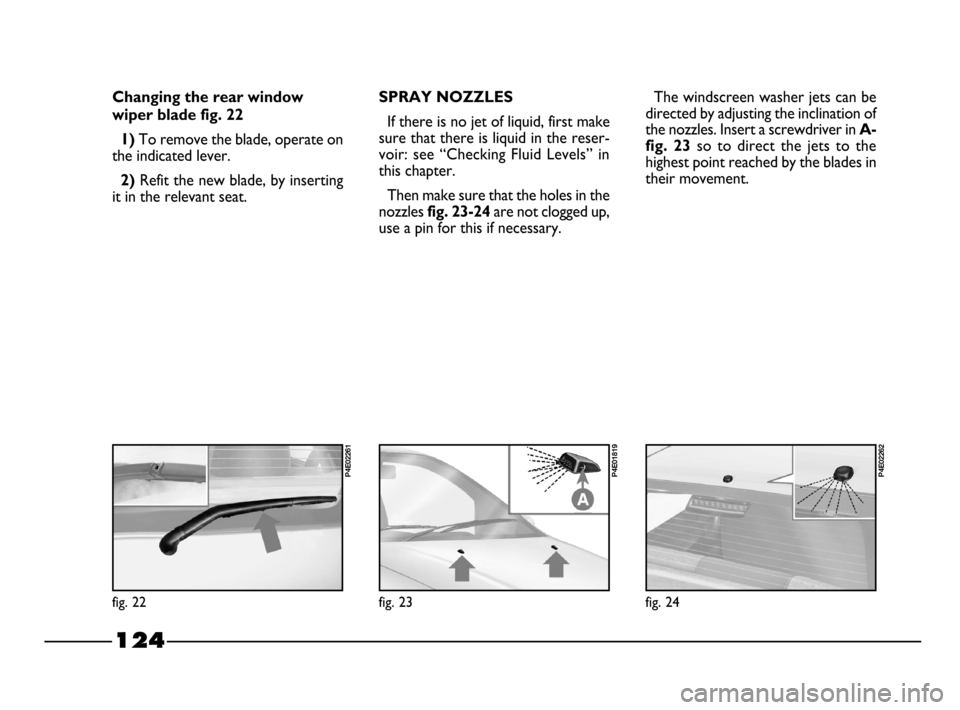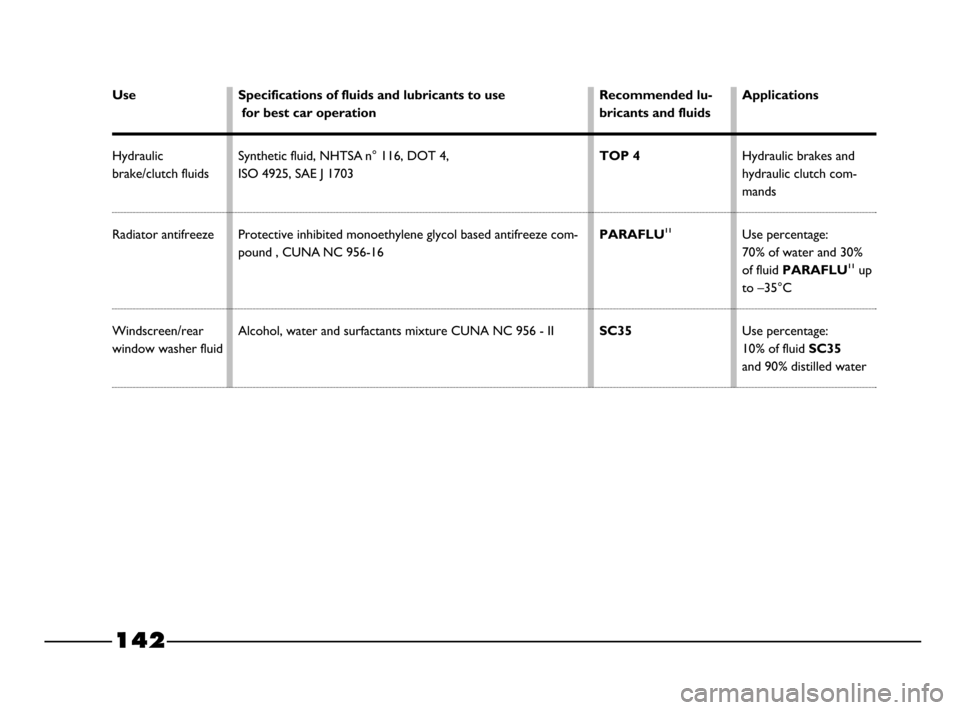2003 FIAT PALIO window
[x] Cancel search: windowPage 115 of 156

114
WINDSCREEN/
REAR WINDOW WASHER
FLUID fig. 9
To add fluid, remove the cap and
pour a mixture of water and 10% of
DPI fluid.
IMPORTANT Do not travel with
the window washer reservoir empty:
the use of the windscreen washer is
fundamental for improving visibility.
fig. 9
P4E01438
fig. 10
P4E01439
Some windscreen wash-
er additives are inflam-
mable. The fluid could ig-
nite if it comes into contact with
parts in the engine compart-
ment.
A dipstick fig. 10 indicates the
amount of fluid in the washer reser-
voir.
When the fluid is fin-
ished, do not operate the
windscreen washer in or-
der to avoid damaging the pump
motor.
fig. 11
P4E02073
POWER STEERING FLUID
Fig. 11:
1.2 version
Fig. 12: 1.6 16v - 1.9 D version
Check that the level is between the
MINand MAXmarks on the reser-
voir or in correspondence of the up-
per mark (max level) on the dipstick
integral with the reservoir plug, with
the car parked on flat ground and the
engine cold.
When the fluid is hot the level may
rise over the
MAX mark.
If necessary, top up ensuring that the
fluid has the same specifications as that
in the reservoir.
104-127 03/03/2003 06:53 PM Page 114
Page 124 of 156

123
RUBBER TUBING
Follow the Service Schedule to the
letter as concerns supply line, power
steering and brake system rubber tub-
ing. Ozone, high temperatures and
long absence of fluid in the system can
in fact cause the hardening and crack-
ing of the pipes with possible loss of
fluid. A careful check is therefore es-
sential.
WINDSCREEN/
REAR WINDOW
WIPER
BLADES
Periodically clean the rubber part
with suitable products.
Change the blades if the rubber edge
is warped or worn out. You should in
any case change them approximately
once a year.– Remove any snow that has settled
on the glass: besides saving the blades
you will avoid straining the electric
windscreen wiper motor and causing
it to overheat.
– Do not operate the wind-
screen/rear window wipers on dry
glass.
Replacing the windscreen wiper
blades fig. 21
1)
Lift the windscreen wiper arm A
off the glass and position the blade
so as to form a 90° angle with the arm.
2) Push the blade downwards to re-
lease it from the arm
A.
3) Refit a new blade, inserting the
tongue on the proper set of the arm.
Make sure that is locked.
Travelling with worn
wiper blades is dangerous
because it reduces visibil-
ity in bad weather.
Some simple steps can reduce po-
tential damage to the blades:
– If the temperature falls to below
zero, make sure the rubber blade is
not frozen to the glass. If necessary,
free it with a de-icing compound.
fig. 21
P4E01818
104-127 03/03/2003 06:53 PM Page 123
Page 125 of 156

124
SPRAY NOZZLES
If there is no jet of liquid, first make
sure that there is liquid in the reser-
voir: see “Checking Fluid Levels” in
this chapter.
Then make sure that the holes in the
nozzles
fig. 23-24 are not clogged up,
use a pin for this if necessary.The windscreen washer jets can be
directed by adjusting the inclination of
the nozzles. Insert a screwdriver in
A-
fig. 23
so to direct the jets to the
highest point reached by the blades in
their movement.
fig. 23
P4E01819
fig. 24
P4E02262
Changing the rear window
wiper blade fig. 22
1)
To remove the blade, operate on
the indicated lever.
2) Refit the new blade, by inserting
it in the relevant seat.
fig. 22
P4E02261
104-127 03/03/2003 06:53 PM Page 124
Page 127 of 156

126
Detergents pollute wa-
ter. For this reason, the
car must be washed in an
area equipped for the collection
and purification of the liquids
used while washing.
To wash the car properly:
1)Wash the body using a low pres-
sure jet of water.
2)Wipe a sponge with a slightly
soapy solution over the bodywork,
frequently rinsing the sponge.
3) Rinse well with water and dry
with a jet of air or a chamois leather.
When drying the car, be careful to
get at those parts which are not so
easily seen e.g. the door frames, bon-
net and around the headlights where
water can most readily collect. You
should leave the car out in the open
so that any water remaining can evap-
orate more easily.
Do not wash the car after it has been
parked in the sun or while the bon-
net is hot: it could take the shine off
the paint.Outside plastic parts must be cleaned
following the usual car washing pro-
cedure.
Avoid parking the car under trees;
the resinous substances that certain
species of tree shed dull the paintwork
and increase the possibility of rust
forming.
IMPORTANTBird droppings must
be washed off immediately and with
great care as their acid is particularly
aggressive.
Windows
Use specific window cleaners to
clean the windows. Use very clean
cloths to avoid scratching the glass or
damaging its transparency.
TIPS FOR KEEPING THE
BODY IN GOOD CONDITION
Paintwork
The paintwork is not only to make
your car look attractive but also to
protect the steel.
If the paint is scuffed or scratched
deeply you are advised to touch up as
necessary to prevent rust from form-
ing.
Only use genuine products when
touching up the paintwork (see the
“Technical Specifications”).
Ordinary maintenance of the paint-
work means washing it. The frequen-
cy you should do this depends on the
conditions and the environment the
car is driven in. For example:
– in areas with a high level of air pol-
lution;
– on roads sprinkled with road salt-
wash;
– parking under trees which drop
resin. In these cases, you should wash
your car more frequently.
104-127 03/03/2003 06:53 PM Page 126
Page 128 of 156

127
Detergents pollute wa-
ter. The car must there-
fore be washed in an area
equipped for the collection and
purification of the liquids used
while washing.
IMPORTANT
The engine com-
partment should be washed while the
engine is cold and with the ignition key
at
STOP. After washing make sure
that the various protections (e.g. rub-
ber boots and various guards) have
not been removed or damaged.
IMPORTANTTo prevent damage
to the electric heater element, wipe the
inside of the heated rear window gen-
tly in the same direction as the ele-
ments.
Engine compartment
At the end of each winter season,
carefully clean the engine compart-
ment. Have this done at a garage.
INTERIORS
Periodically check that water has not
collected under the mats (from dip-
ping shoes, umbrellas etc.) which could
cause the steel to rust
CLEANING SEATS AND
FABRIC COMPONENTS
– Remove dust with a soft brush or
vacuum cleaner.
– Brush the seats with a damp
sponge with water and a neutral soap.
Never use flammable
products (petroleum
ether or petrol) to clean
the inside of the car. Electro-
static charges generated by rub-
bing while cleaning could cause
fires.
Do not keep aerosol
cans in the car. There is
the risk they might ex-
plode. Aerosol cans must never
be exposed to a temperature
above 50°C; when the weather
starts to get hot the temperature
inside the car might go well be-
yond that figure.
PLASTIC PARTS INSIDE THE
CAR
Use special products designed not to
alter the appearance of the compo-
nents.
IMPORTANTDo not use alcohol
or petrol to clean the glass of the in-
strument panel.
104-127 03/03/2003 06:53 PM Page 127
Page 141 of 156

1.2
litres kg
47 –
5.5-7.5 –
5.9 6.1
3.05 2.75
1.8 1.5
0.68 0.54
– 0.075
0.40
0.50
2.3 –
1.6
litre kg
47 –
5.5-7.5 –
6.6 6.8
3.88 3.5
1.8 1.5
0.68 0.54
– 0.075
0.40
0.50
2.3 –
140
Prescribed fuels
Recommended products
Super unleaded petrol 87 R.O.N.
Mixture composed by 70% distilled water
and 30% fluid
PARAFLU11
VS MAX PETROL(*)
ZC 80/S
GI/A
MRM 2
TOP 4
TOP 4
Mixture of distilled water and 10% of fluid DPI
CAPACITIES
(*) Do not top up with oil having specifications different from the oil present in the car.
47 –
5.5-7.5 –
4.8 3.9
43.3
2.0 1.73
0.68 0.54
– 0.075
0.40 –
0.50
2.3 –
1.9
litre kg
Fuel tank:
including a reserve of:
Engine cooling system:
– with manual climate control system
ngine sump:
Engine sump and filter:
Transaxle:
Hydraulic power steering:
CV joint cavities and boots :
Front and rear hydraulic brake circuit:
Hydraulic brake circuit with
ABS antilock device:
Windscreen/rear window washer
fluid reservoir:
128-143 03/03/2003 07:39 PM Page 140
Page 143 of 156

142
Use
Hydraulic
brake/clutch fluids
Radiator antifreeze
Windscreen/rear
window washer fluid
Specifications of fluids and lubricants to use
for best car operation
Synthetic fluid, NHTSA n° 116, DOT 4,
ISO 4925, SAE J 1703
Protective inhibited monoethylene glycol based antifreeze com-
pound , CUNA NC 956-16
Alcohol, water and surfactants mixture CUNA NC 956 - II
Recommended lu-
bricants and fluids
TOP 4
PARAFLU
11
SC35Applications
Hydraulic brakes and
hydraulic clutch com-
mands
Use percentage:
70% of water and 30%
of fluid
PARAFLU11up
to –35°C
Use percentage:
10% of fluid
SC35
and 90% distilled water
128-143 03/03/2003 07:39 PM Page 142
Page 145 of 156

Abord instrument ................... 33
ABS ................................................. 56
Accessories Purchased
Air cleaner (replacement) ....... 116
Air bag ........................................... 58
Air re-circulation.......................... 40
Air vents......................................... 38
Alternator (specifications) ........ 137
Ashtray ........................................... 47
Battery
- jump starting ......................... 81
- specifications........................... 137
- with optical hydrometer .... 119
- useful advices .......................... 118
- maintenance ............................ 118
- recharging ................................ 98
Bodywork
- bodywork type code ........... 130
- maintenance .......................... 125Boot
- extending ................................. 52
- tailgate opening/closing ........ 16-51
Brake lights
(bulb replacement) ................. 90
Brake-clutch fluid level ............... 115
Brakes
- service and emergency ....... 134
- fluid level ................................ 115
Bulb (replacement) ..................... 86
- bulb types ............................... 86
By the Owner ............................... 79Car dimensions ......................... 139
Car maintenance ......................... 104
Ceiling lights
- control ..................................... 46
- bulb replacement ................... 92
Centralized locking .................... 17-49
Chassis(marking) ......................... 129
Cheap running that respects
the environment ..................... 73
Checking the levels .................... 111
Children safety ............................ 18-49
Climate control system- climate ..................................... 39
- controls.................................... 14-39
- fast demisting ........................ 40
- maintenance .......................... 125
- air re-circulation .................... 40
- heating ...................................... 39
Climate/heating control
system ........................................ 37
Clutch ............................................. 133
Containing running costs and
pollution .................................... 75
Control switches ........................ 15-44
Correct use of your car ............ 64
Dashboard ................................ 9
Demisting ....................................... 40
- rear window .......................... 40
- windscreen and side
window ...................................... 40
Differential ..................................... 133
Digital clock ................................. 34
INDEX
144
144-152 03/03/2003 07:30 PM Page 144